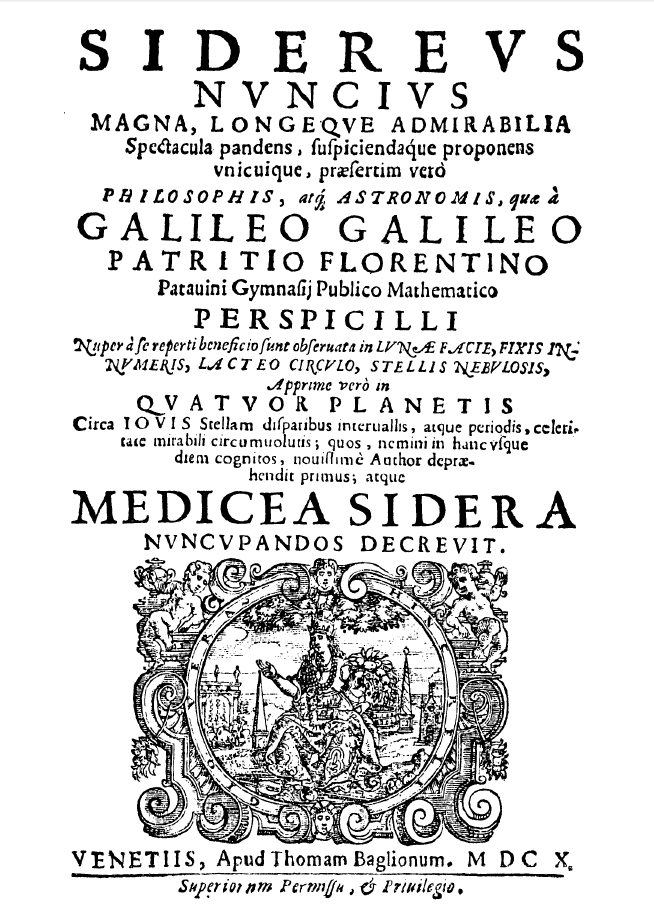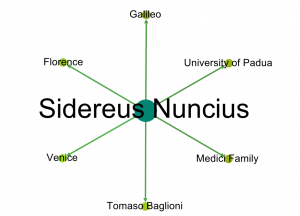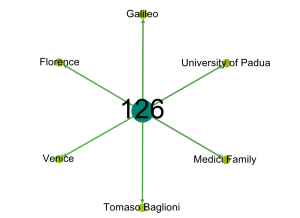How are people and places connected through the title pages of the books in Galileo’s library?
A consideration of book ownership and the relationship between material objects and the circulation, support, or censorship for ideas must also acknowledge reading practices as historical constructs. By exploring what Brendan Dooley has recently labeled the “marketplace for information and knowledge”, this examination of Galileo’s ownership of works of astronomy in particular, highlights the power and capital driving and resisting the representation and the circulation of ideas in print in this time of such controversy.1 I think this also aligns with Moretti’s rationale for distant reading specific morphologies against the broader corpus, the market. The data that I am using are particularly focused on Genette’s theorization of paratextual frames, the frames through which a conscientious consumer of print culture would interpret the contents of a book. This metadata, the data about the book, is a potent field for communication between authors, printers, patrons, and readers.
First, a close reading of one example, taken as synecdoche for the method. Galileo’s Sidereus nuncius or Starry Messenger, published in Venice in early 1610, presents Galileo’s observations of heavenly bodies with his modified telescope. In addition to observing what he correctly interpreted as mountains and craters on the moon’s surface, Galileo also documented his observation of four previously unseen stars that he determined to be orbiting Jupiter. The imperfect lunar surface and the appearance of apparent stars orbiting something other than earth undermined Aristotelian and Ptolemaic conceptions of the structure of the cosmos and leant controversial weight to the Copernican hypothesis of heliocentrism.

Title page as reprinted in Favaro’s edition of Galileo’s works, Vol. III, p. 53. [n]
Directing our gaze to the bottom of the page we see the printer’s mark and the final metadata for the book. Nick Wilding’s painstaking research on the material history of the first printing of the Starry Messenger has not only prevented a recent multi-million dollar auction of a forgery of the work, but has also shown that Tomaso Baglioni’s name on the title page was “legally irregular.”2 By tracing the heritage of books printed by Baglioni along with printers’ marks and woodcuts, Wilding has convincingly shown that Galileo deliberately chose a printer and editor for the Starry Messenger who could insert his work into a particular network of rebellious Venetian intellectuals. Their work was often as controversial in its support of heretical ideas as it was licentious in it distribution of erotica. Wilding’s work was laborious because he needed to recreate a historical moment whose evidence had been dispersed across Italian libraries over the course of four centuries. Frequent early modern Venetian book buyers would have likely already been aware of the visual and verbal cues hidden in the book’s metadata.
In order to test the value of someone like Baglioni as a piece of coded cultural communication in the larger network, I needed to convert bibliographic information to data that could be read by an application designed for mathematical analysis of network structures. What you see here is essentially how the Starry Messenger will be represented within the larger network. The book itself, the Sidereus nuncius, is the central hub, called a node; it is large because it is connected to more things than the other nodes. The connections to the author, printer, place of printing, and the other people and places from the title page are lines called edges. Edges represent a relationship. In this case the relationship is that the title page of the book mentions the people and places indicated as nodes on the spokes. I am treating the data as expressions of participation in, or the desire to participate in, the network represented by those cues, not as statement of fact, to account for false imprints.
Now we can ask where the book connects with works on astronomy and works on other subjects in the library. Florence and Venice, as you can imagine, given Galileo’s work and living patterns, are two of the most connected nodes in the library.

Gephi rendering of the information on the title page of the 1610 edition of the Sidereus Nuncius.

Gephi rendering of the information on the title page of the 1610 edition of the Sidereus Nuncius using the ID number from Prof. Hall’s database in place of the title.
Examples of Network Visualization and Analysis at work:
All networks are visualized using Gephi, an open-source tool.
[1] Dooley, Early Modern Italy, 210.
[2] See Walsby & Constantini, 11-14.
[3] 95.